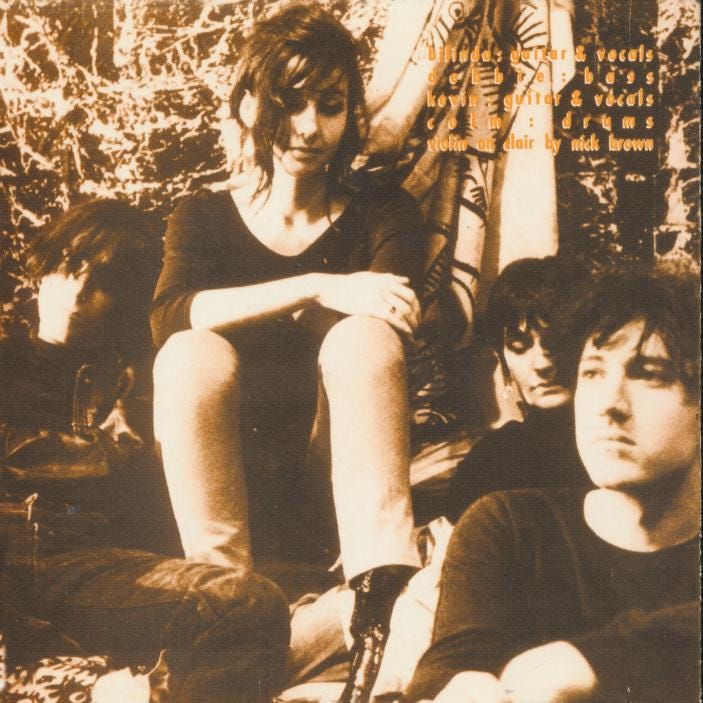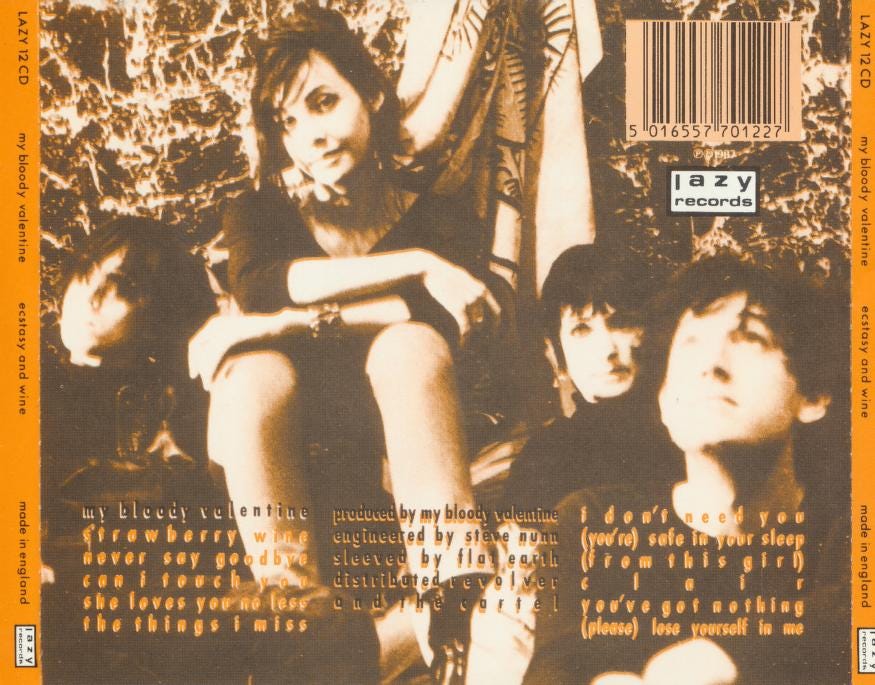
My Bloody Valentine was formed in 1987 after Bilinda Butcher picked up a guitar and started singing ethereal death melodies about sex into a microphone.
Actually, that’s not true; My Bloody Valentine was founded much earlier by friends Kevin Shields and Colm Ó Cíosóig, who met at a karate tournament as teenagers in Dublin, Ireland, circa 1979. Kevin was an exceptional guitarist influenced by the Ramones, Johnny Marr’s melody-making in The Smiths, and the forsaken spider-web noir of Siouxsie’s Banshees, and Colm was a hard-hitting punk drummer of similar tastes; the two got along instantly and later formed My Bloody Valentine along with singer David Conway, the former of whom would later leave the band to pursue a career in writing, leaving Kevin Shields as the sole creative force behind the band’s music.
(All members now insist that they weren’t aware that the name “My Bloody Valentine” was the title of a slasher film from 1981; likely a “we thought of it first” saving-of-face because of how edgy the band name sounds (that’s what I’d do). To this day, whenever I talk to people about My Bloody Valentine, they think I’m referring to some mid-2000s screamo band, so now I just don’t talk about them at all unless I know the person is on my “musical wavelength.” Of course, anyone who knows My Bloody Valentine knows that they claimed the name as their own, and it’s now almost exclusively associated with them, their excellence defining the words themselves.)
My Bloody Valentine went through numerous lineup changes and released a handful of EPs of middling quality before recruiting Bilinda Butcher in 1987. Bilinda wasn’t anything special; well, she was, but not when it came to playing the guitar, of which she would be playing rhythm, and her singing was amateur at best. However, there was a haunting innocence in her tenor that complemented the band’s playful, feedback-ridden doom and gloom. My Bloody Valentine had The Smiths’ melodies but was missing the Aztec human sacrifice of Siouxsie and the Banshees. In short, they were missing a crucial piece of the puzzle, and Bilinda was that missing puzzle piece; she fit perfectly, and with her inclusion: My Bloody Valentine became what we know them as today.

To understand My Bloody Valentine’s early sound, one has to grasp what was happening in the Scottish music scene during the early ‘80s. Well, not really; one just has to listen to the increasingly hard-to-find early recordings of My Bloody Valentine, but context never hurts. There were two very important bands in Scotland during this era. One is well-known: The Jesus and Mary Chain, two brothers (William and Jim Reid) with a drum machine who made feedback-riddled bedroom pop influenced by surf rock, specifically the Beach Boys. The other was the lesser-known but very influential band The Pastels, led by Stephen McRobbie.
The Jesus and Mary Chain released their debut album “Psychocandy” in 1985 and, with that, pioneered a genre later dubbed “noise pop,” which would eventually spin off into the vacuum cleaner sound of “shoegaze.“ Noise pop was just that — very noisy guitar pop full of feedback and distortion, heavily influenced by the Beach Boys, The Byrds, and other guitar pop bands of the ‘60s and ‘70s.
The Pastels formed in 1980 and spearheaded the “anorak pop” movement in Glasgow, Scotland a genre named after the brand of jacket, ‘anorak,’ a form of parka often worn by perceived simple ‘low-class’ children and teenagers at the time. This style of music, adjacent to noise pop, can be best described as hook-driven primitive pop music, ‘purposely’ of an untrained poor quality – something a child might produce in their bedroom on play instruments; a willful naivete, escapism with lyrics about young love, playing kickball, and doing chores – or whatever kids did back then. Not so much a movement as a transparent deflection of criticism at the musician’s perceived (and often very real) lack of talent (“we’re not supposed to sound good – we’re anorak pop!”). This genre eventually branched off into “twee,” which is so saccharine that it is indistinguishable from sickening; and while it may seem like I have a disdain for this genre of music, The Pastels are a clear exception as they produced some incredibly catchy music that featured both a male and female vocalist sharing singing duties, often within the same song as a form of “singing back and forth to each other,” as heard on one of the greatest pop songs ever written — ‘Nothing to be Done.’
(I was obsessed with both The Pastels and twee pop for a brief period in 2008, where I actually formed a band called “The Crayons,” influenced by The Pastels. We eventually changed our name to “Golly Gee,” but the band disbanded due to competition for the only girl in the band’s affection between myself and the guitarist, who is one of my only ‘real’ friends to this day. Like The Pastels in the early ’80s, their influence reached out into the 2000s and affected even myself.)
While My Bloody Valentine was based in Ireland, the Scottish influence of both The Pastels and Jesus and Mary Chain sailed over the Irish Sea and can be heard throughout My Bloody Valentine’s early recordings, surfacing with full power in their 1987 EP, “Sunny Sundae Smile,” in which a still malformed version of the band, led by vocalist David Conway, played fuzzy guitars over childlike pop songs that were secretly about necrophilia (‘Paint a Rainbow’) – “Earthen trail of slimy goo; I smear it on your cheeks like rouge” – and incest (‘Sunny Sundae Smile’) – “Close your eyes and let’s pretend we’re little children once again!” (The Crayons covered this song). This cemented My Bloody Valentine’s intention to subvert listeners’ expectations: they sounded grandma-sweet but were actually singing about Doing It With Dead People; their music was simple verse-chorus-verse-chorus jangle pop at its core but it was washed in layers of nasty guitar feedback.
“(we wanted to play) the most beautiful songs with the most extremeness of physicality and sound”
– Kevin Shields, The Guardian, 2021
Later in 1987, David Conway left the band to pursue writing, and Bilinda Butcher was recruited. My Bloody Valentine then released their greatest material to that point: two EPs, one titled “Strawberry Wine” and another called “Ecstasy.” Both of these are combined on the 1989 compilation album “Ecstasy and Wine,” which happens to be the topic of this long-winded essay. Kevin Shields now has full reign over the band’s direction, and as a result, there is a mastery of what came before: the wistful twee pop melodies have been perfected and the guitar feedback sounds less forced and more a natural extension of the music.
The album starts with the track ‘Strawberry Wine,’ taking full advantage of Bilinda Butcher’s vocals to add a ghostly choral harmony over the entire song. This use of vocals is reminiscent of how Kevin Shields would layer multiple guitar tracks to create unique walls of sound on future albums, particularly on “Loveless.” Following up from this is the monumental 2-minute pop epic ‘Never Say Goodbye,’ in which Kevin and Bilinda play the role of lovers singing back and forth to each other in alternating verse, similar to The Pastels’ ‘Nothing to be Done,’ only released a year earlier – possibly a case of the influenced influencing the influencers.
“Ecstasy and Wine” functions as both its own complete album, full of well-crafted infinitely repeatable pop songs, but also a precursor to everything My Bloody Valentine becomes known for later on. Tracks like ‘(Please) Lose Yourself In Me,’ ‘Can I Touch You,’ and ‘Clair’ with their deep basslines and lazy sludge-like progression hint at many of the songs on their first official LP, 1988’s “Isn’t Anything,” specifically tracks such as ‘Soft As Snow (But Warm Inside)’ and ‘Cupid Come,’ all of which are about sex in one form or another (an ongoing theme throughout all their music). Every song is laced with a layer of fuzzy proto-shoegaze noise hovering over shimmering guitar melodies.
The near perfect pop found on “Ecstasy and Wine” is never this crystal clear again with My Bloody Valentine; progressively washed away in noise with each additional release. Tracks such as the Bilinda Butcher-led ‘She Loves You No Less’ (my favorite cut on the album), ‘I Don’t Need You,’ and ‘You’ve Got Nothing’ are some of the most hook-laden guitar pop you’ll find outside of The Smiths’ ‘This Charming Man.’ My Bloody Valentine’s future work on “Loveless” and other EPs, including tracks such as ‘Thorn,’ ‘Honey Power,’ ‘Off Your Face,’ and ‘When You Sleep,’ borrows from these pop elements generously but never quite reaches the same level of joyful bounciness found on “Ecstasy and Wine,” an album that showcases a band on the verge of revolutionizing rock music but also just a really solid four-piece with an excellent grasp of melody.
My Bloody Valentine may have gone on to change rock music forever, but before that, they were making some of the best jangle pop (secretly) about sex that you will ever hear in your life.

(This entire album is on YouTube; but YouTube is awful and I wouldn’t advocate supporting them. Outside of purchasing the album directly from the band, which you can’t even do anymore, you can find it on Archive.org or simply send me a private message and I’ll send you a zipped copy. Trust me, it’s worth it. My first experience with My Bloody Valentine was Loveless, after hearing Billy Corgan mention it in an interview when I was really young; a timeless classic, but hard to get into. To this day, I find myself more in the mood for Ecstasy and Wine over Loveless, and, considering the classic deserted island hypothetical, would likely pick Ecstasy and Wine over Loveless 9 times out of 10.)